1-d
2-d
3-d
Density of states
$D(E) = \begin{cases} \frac{D_v}{\sqrt{E_v-E}}, & \mbox{for } E\lt E_v \\ 0, & \mbox{for } E_v\lt E\lt E_c \\ \frac{D_c}{\sqrt{E-E_c}}, & \mbox{for } E_c \lt E \end{cases}$
$D(E) = \begin{cases} D_v, & \mbox{for } E\lt E_v \\ 0, & \mbox{for } E_v\lt E\lt E_c \\ D_c, & \mbox{for } E_c \lt E \end{cases}$
$D(E) = \begin{cases} D_v\sqrt{E_v-E}, & \mbox{for } E\lt E_v \\ 0, & \mbox{for } E_v\lt E\lt E_c \\ D_c\sqrt{E-E_c}, & \mbox{for } E_c \lt E \end{cases}$
Density of states
$m_e^*$ and $m_h^*$ are 'density of states' effective masses
$D(E) = \begin{cases} \frac{1}{\hbar\pi}\sqrt{\frac{2m^*_h}{E_v-E}}, & \mbox{for } E\lt E_v \\ 0, & \mbox{for } E_v\lt E\lt E_c \\ \frac{1}{\hbar\pi}\sqrt{\frac{2m^*_e}{E-E_c}}, & \mbox{for } E_c \lt E \end{cases}$
$D(E) = \begin{cases} \frac{m_h^*}{\hbar^2\pi}, & \mbox{for } E\lt E_v \\ 0, & \mbox{for } E_v\lt E\lt E_c \\ \frac{m_e^*}{\hbar^2\pi}, & \mbox{for } E_c \lt E \end{cases}$
$D(E) = \begin{cases} \frac{(2m_h^*)^{\frac{3}{2}}}{2\pi^2\hbar^3}\sqrt{E_v-E}, & \mbox{for } E\lt E_v \\ 0, & \mbox{for } E_v\lt E\lt E_c \\ \frac{(2m_e^*)^{\frac{3}{2}}}{2\pi^2\hbar^3}\sqrt{E-E_c}, & \mbox{for } E_c \lt E \end{cases}$
Density of states
$N_v$ and $N_c$ are effective densities of states
$D(E) = \begin{cases} N_v(300)\sqrt{\frac{2}{300\pi k_B(E_v-E)}}, & \mbox{for } E\lt E_v \\ 0, & \mbox{for } E_v\lt E\lt E_c \\ N_c(300)\sqrt{\frac{2}{300\pi k_B(E-E_c)}}, & \mbox{for } E_c \lt E \end{cases}$
$D(E) = \begin{cases} \frac{N_v(300)}{300k_B}H(E_v-E), & \mbox{for } E\lt E_v \\ 0, & \mbox{for } E_v\lt E\lt E_c \\ \frac{N_c(300)}{300k_B}H(E-E_c), & \mbox{for } E_c \lt E \end{cases}$
$D(E) = \begin{cases} \frac{2N_v(300)}{\sqrt{\pi}}\left(\frac{1}{300k_B}\right)^{\frac{3}{2}}\sqrt{E_v-E}, & \mbox{for } E\lt E_v \\ 0, & \mbox{for } E_v\lt E\lt E_c \\ \frac{2N_c(300)}{\sqrt{\pi}}\left(\frac{1}{300k_B}\right)^{\frac{3}{2}}\sqrt{E-E_c}, & \mbox{for } E_c \lt E \end{cases}$
Density of electrons
in the conduction band
$n=\int\limits_{E_c}^{\infty}D(E)f(E)dE$
$n=\sqrt{\frac{m_e^*k_BT}{\hbar^2\pi}}\exp\left(\frac{\mu-E_c}{k_BT}\right)\quad\text{m}^{-1}$
$=N_c(T)\exp\left(\frac{\mu-E_c}{k_BT}\right)$
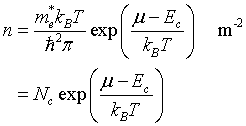
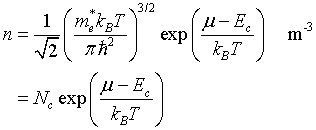
Density of electrons
in the conduction band
$n=\int\limits_{E_c}^{\infty}D(E)f(E)dE$
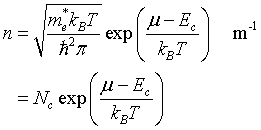


Density of holes
in the valence band
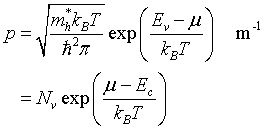
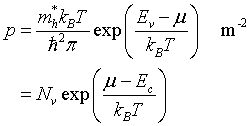

Law of mass action



Intrisic carrier density



Chemical potential
Set n = p, solve for μ



Internal energy density



Helmholtz free energy
f = u - Ts



Specific heat



Entropy


